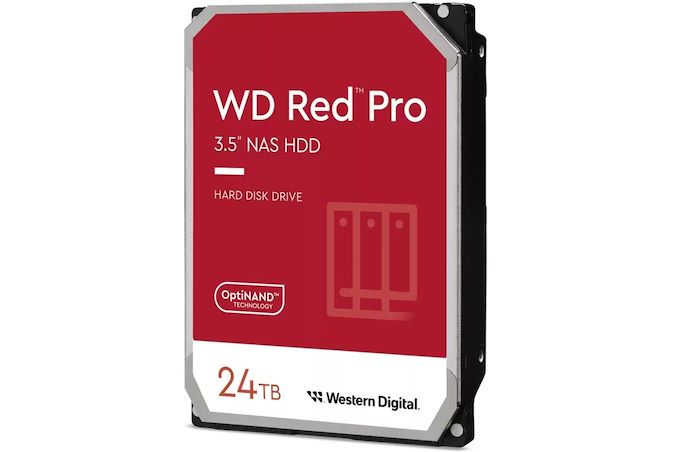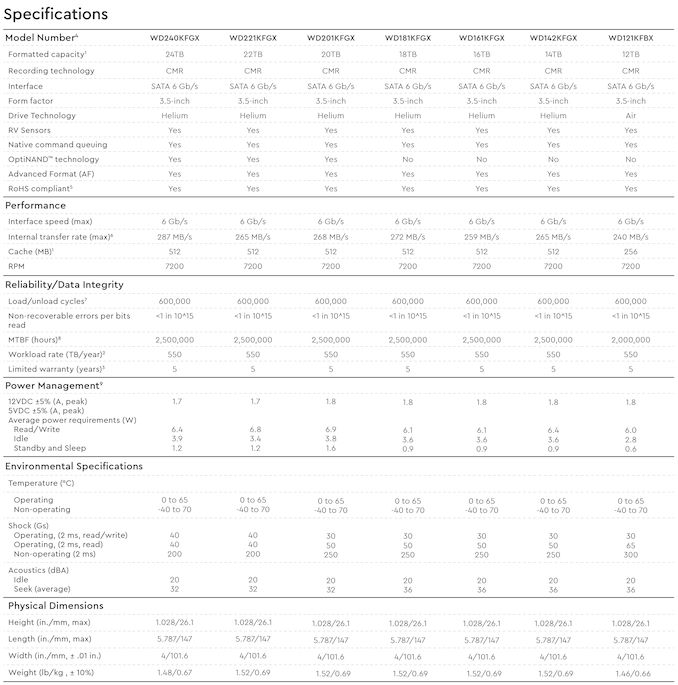Western Digital Ships 24TB Red Pro Hard Drive For NASes [UPDATED]
by Anton Shilov on March 28, 2024 12:00 PM EST- Posted in
- Storage
- HDDs
- Western Digital
- Helium HDD
- WD Red Pro
- HDD

Nowadays highest-capacity hard drives are typically aimed at cloud service providers (CSPs) and enterprises, but this does not mean that creative professionals or regular users do not need them. To cater to demands of more regular consumers, Western Digital has started shipments of its Red Pro 24 TB HDDs, which are aimed at high-end NAS use for creative professionals with significant storage requirements.
Western Digital's Red Pro 24 TB hard drives come approximately 20 months after their 22 TB model hit retail in 2022, offering an incremental improvement to WD's highest-capacity NAS and consumer hard drive offering. The platform uses conventional magnetic recording (CMR), feature a 7200 RPM rotating speed, are equipped with a 512 MB cache, and use OptiNAND technology to improve reliability as well as optimize performance and power consumption. The HDDs are rated for an up to 287 MB/s media to cache transfer rate, which makes them some of the fastest hard drives around (albeit, still a bit slower compared to CSP and enterprise-oriented HDDs).
Just like other high-end network-attached storage-aimed HDDs, the Red Pro 24 TB hard drives use helium-filled platforms that are very similar to those designed for enterprise drives. Consequently, the Red Pro 24 TB HDD are equipped with rotation vibration sensors to anticipate and proactively counteract disturbances caused by increased vibration and multi-axis shock sensors to detect subtle shock events and automatically offset them with dynamic fly height technology to ensure that heads to not scratch disks.
UPDATE 4/2/2024: Western Digital has notified us that WD Red Pro fully support ArmorCache capability, even though it is not listed in datasheets.
What these drives lack compared Apparently, just like WD Gold and Ultraster 22 TB and 24 TB drives for enterprises and cloud datacenters, WD Red Pro HDDs fully support the ArmorCache feature that provides protection against power loss when write-cache is enabled (WCE mode) and enhances performance when write-cache is disabled (WCD mode).
On the reliability side of matters, Western Digital's Red Pro 24 TB HDDs are designed for 24/7 operation in vibrating environments, such as enterprise-grade NAS with loads of bays, and are rated for up to 550 TB/year workloads as well as up to 600,000 load/unload cycles, which is in line with what Western Digital's WD Gold and Ultrastar hard drives offer.
As for power consumption, the WD Red Pro 24 TB consumes up to 6.4W during read and write operations, up to 3.9W in idle mode, and up to 1.2W in standby/sleep mode.
Western Digital's Red Pro 24 TB (WD240KFGX) HDDs are now shipping to resellers as well as NAS makers, and are slated to be available shortly. Expect these hard drives to be slightly cheaper than the WD Gold 24 TB model.
Source: Western Digital











18 Comments
View All Comments
pugster - Thursday, March 28, 2024 - link
What I am surprised is that they have non-helium 12tb drive WD121KFBX. I wonder if they put 5 - 2.4tb platters in it?Samus - Thursday, March 28, 2024 - link
I was under the impression the largest non-helium drive was 10TB. While I am a fan of helioseal drives for their low noise and low power, I wish "coolspin" drives would make a comeback because for archiving and cold storage, the perceived reliability of a low spindle speed, heat output, power consumption, and (tremendously) lower noise profile make them desirable for what is in my experience a negligible hit to overall performance. I still have many 4TB HGST coolspin drives in service that transfer 200MB/sec sustained. The access time is obviously 33% slower but if you are storing 4-8GB video files or thousands of 50-100MB RAR's, access time is mostly irrelevant.eldakka - Thursday, March 28, 2024 - link
The use-case you are describing is precisely what SMR drives are designed for.Samus - Friday, March 29, 2024 - link
Except they're still 7200RPM, so they run hotter, consume more power, make more noise...literally all of my complaints about 7200RPM drives still apply to SMR.Really weird, pointless comment.
PeachNCream - Friday, March 29, 2024 - link
Depending on your usage, hearing the difference between 5400 and 7200 RPM drives might be difficult when other factors are considered. Personally, I haven't been able to discern any noteworthy difference.Samus - Sunday, March 31, 2024 - link
Harmonics and vibration are substantially different between 5400RPM and 7200RPM drives. The precursor to smartphone apps that detected the sound signature to determin WD was initially selling 5400RPM drives as 7200RPM drives rated at "5400RPM class" was the fact people were suspicious simply based on human hearing of various users.I don't keep my PC's on the floor and they are unfortunately often ear-level on my desk, and the difference between a case with 2-3 5400RPM drives and a case with 2-3 7200RPM drives is notable from anywhere in the room, no matter how well you insulate the case.
There are clear benefits to 5400RPM drives, but the industry has seized producing them because having a single architecture to base all drives on at scale is substantially cheaper than two architectures. The motor and calibration are entirely different and from a marketing perspective most buyers want the 'faster RPM.' Clearly I am in the minority, maybe I have sensitive hearing, who knows. But I know I am in a small subset of buyers that would like a product that isn't cost feasible for the industry to produce, so I get it. But it's still a wish.
GeoffreyA - Monday, April 1, 2024 - link
Noise aside, I agree with the benefits of these slower-spinning drives. Today's 5400-RPM drives are not the drives of ten, twenty years ago. Back then, with smaller sizes, they were frustratingly slower, colouring our views.I have a 5400-RPM 4 TB Blue and have no complaints with its performance. Transfer rates are higher than the 7200-RPM 500 GB Baracuda it replaced. If I had to choose a slower-spinning drive again, I would.
HaninAT - Wednesday, April 3, 2024 - link
At times, I do lament my time as a car audio fanatic... then I am reminded that it allows me to remain oblivious to my expansive computer equipment's noise, and most hi pitched sounds (above 6khz). I do keep the bulk of it in a dedicated room in my home, but it is extremely difficult to avoid fan noise in today's world. Oh, a world with mild hearing loss is a splendid one, indeed!GeoffreyA - Thursday, April 4, 2024 - link
HaninAT. My imagination runs amok with imagery of rattling windows, as the subs, 6x9s, and tweeters do their thing!Dug - Wednesday, April 3, 2024 - link
There is a big difference in my opinion. I only use 10TB shucked WD 5400 drives. Anything else sounds like nails on a chalkboard.